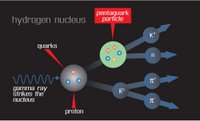Technorati Tags: Estrogen or stress and Gabapentin or Medical and hot flashes or menopause and Gynecology or sex hormones and hormone replacement therapy or biology and HRT or postmenopausal and women
 |
Rochester continues search for alternative menopause treatments
University of Rochester researchers, who have been investigating new therapies for hot flashes for several years, report in the July Obstetrics and Gynecology journal that the seizure drug gabapentin is as effective as estrogen, which used to be the gold standard treatment for menopause symptoms.
Estrogen is no longer the preferred therapy because recent, large studies have shown that the hormone increases the risk of heart disease, stroke, breast cancer and Alzheimer's disease for some women. Given that news, millions of women have abandoned hormone replacement therapy (HRT) and are seeking other ways to ease symptoms. So-called natural remedies such as soy, herbal products or acupuncture have not proven safe or effective at this point.
The latest Rochester study is the first to compare gabapentin and estrogen head-to-head against a placebo. Although it showed a substantial placebo effect similar to other menopause studies – women taking the sugar pill reported a 54-percent reduction in hot flashes – the women taking gabapentin and estrogen reported even better results, with a 71 percent to 72 percent decline in symptoms.
"Gabapentin does appear to be as effective as estrogen," said lead author Sireesha Y. Reddy, M.D., assistant professor of Obstetrics and Gynecology at the University of Rochester Medical Center. "Until now its efficacy relative to estrogen was unknown."
Approximately 75 percent of postmenopausal women between the ages of 35 and 60 experience hot flashes. Gabapentin (sold under the trade name Neurontin) was approved by the FDA in 1994 to treat epileptic seizures but has been used off-label for years to treat headaches, shingles pain and other ailments. Scientists hypothesize that gabapentin may reduce hot flashes by regulating the flow of calcium in and out of cells, which is one mechanism for controlling body temperature.
An expert panel on menopause convened by the National Institutes of Health last year cautioned against the tendency to use treatments with scant safety data, and concluded that nothing to date was as effective as estrogen therapy although more research was needed.
In the latest study, Reddy and colleagues enrolled 60 women in a randomized, double-blind, placebo-controlled trial for 12 weeks. Initially the researchers received more than 1,500 calls from women who wanted to participate, but after screening the callers to meet the study's protocol, the number was whittled to 60, with 53 women complying with every step.
They were randomly divided into three groups: 20 women received gabapentin at 2,400 mg per day and a daily placebo or fake estrogen pill; 20 received estrogen in the form of Premarin at 0.625 mg per day and a fake gabapentin pill; 20 received sugar pills resembling gabapentin and estrogen. The women recorded the frequency and severity of their hot flashes in diaries.
Results were tabulated using two statistical methods to compare the women's hot flash reports throughout the 12-week period with their baseline symptoms. Doctors did find that women who took gabapentin complained more often of headaches, dizziness or disorientation. Researchers believe that slowly ramping up the medication and taking it with meals can alleviate the side effects. ###
The NIH funded the study. Pfizer Inc. supplied gabapentin but had no role in the research. A co-author on the paper, Thomas Guttuso Jr., M.D., has a patent for the use of gabapentin in the treatment of hot flashes. Guttuso is a former neurologist at the University of Rochester who is now on the faculty at the University of Buffalo.
University of Rochester Medical Center Contact: Leslie Orr Leslie_Orr@urmc.rochester.edu585-275-5774
Related: Keyword biology, Sunday, June 25, 2006 Estrogen plays different role during stress in black and white teens, Sunday, June 25, 2006 Our grip on reality is slim, Sunday, May 21, 2006 Genome doesn't start with 'G', Sunday, May 07, 2006 Lying Is Exposed By Micro-Expressions We Can't Control, Sunday, April 30, 2006 Mothers often have inaccurate perceptions of their children's body weight, Sunday, April 16, 2006 Other people influence us and we don't even know it!, Tuesday, January 04, 2005 The Cassini-Huygens mission to Saturn, Sunday, March 20, 2005 Agriculture Secretary Mike Johanns, bovine spongiform encephalopathy (BSE), Thursday, March 24, 2005 Fish Oil Holds Promise in Alzheimer's Fight, Sunday, April 10, 2005 National Human Genome Research Institute (NHGRI), Friday, April 15, 2005 Study uncovers bacteria's worst enemy , Sunday, May 01, 2005 Yes, it is an exoplanet 2M1207 system, Friday, May 20, 2005 a polysaccharide called hyaluronan, Tuesday, May 24, 2005 pseudoneglect phenomenon, Friday, June 03, 2005 DOE JGI sequences DNA from extinct cave bear, Monday, June 06, 2005 From a Few Wild Ancestors, a Citrus Cornucopia, Tuesday, June 07, 2005 NHGRI Selects 13 More Organisms for Genome Sequencing, Sunday, July 24, 2005 Prehistoric Native Americans maize cultivation ,









